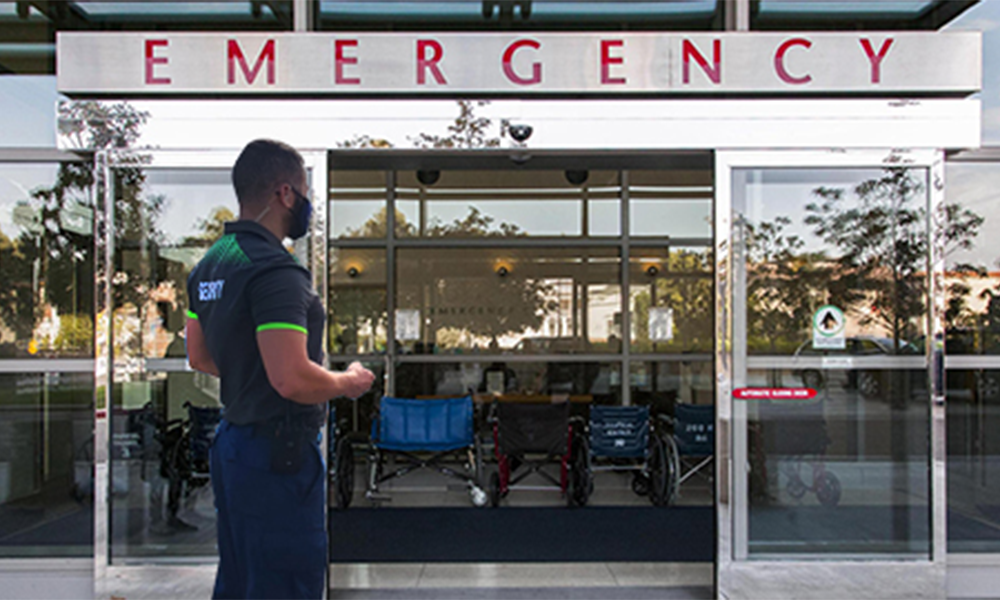Healthcare facilities, including hospitals, face a myriad of security challenges due to their open and accessible nature. Unlike other commercial establishments, hospitals cater to individuals with diverse backgrounds and medical conditions, making them susceptible to a range of security threats. From thefts and assaults to unauthorized access and patient elopement, the safety concerns within healthcare settings are multifaceted and demand tailored security solutions.
Key Elements of Hospital Security:
Access Control:
Implementing stringent access control measures is fundamental to hospital security. This involves regulating entry points, restricting unauthorized access to sensitive areas such as operating rooms and pharmaceutical storage, and utilizing technologies like electronic keycards and biometric authentication systems to monitor and manage access rights.
Surveillance Systems:
Surveillance cameras serve as crucial tools in the overall security framework of hospitals and healthcare facilities. By providing continuous monitoring and recording capabilities, these systems offer real-time insights into activities within the premises. The presence of surveillance cameras acts as a deterrent to potential threats, discouraging unauthorized individuals from engaging in criminal behavior.
Strategic Placement:
The effectiveness of surveillance systems relies heavily on the strategic placement of cameras throughout the facility. Areas requiring heightened security, such as emergency departments, entrances and exits, critical care units, and parking lots, should have ample coverage.
Additionally, high-traffic areas like corridors, waiting rooms, and reception areas benefit from surveillance to monitor patient flow and identify potential security risks.
Types of Cameras:
Hospitals deploy various types of surveillance cameras to meet specific security needs. Fixed cameras offer stationary monitoring of designated areas, while pan-tilt-zoom (PTZ) cameras provide flexibility in adjusting the field of view and zooming capabilities for detailed observation.
Dome cameras, discreetly positioned within ceiling fixtures, offer unobtrusive surveillance, ideal for maintaining a non-intrusive environment.
Integration with Security Systems:
Modern surveillance systems are often integrated with other security technologies to enhance overall effectiveness. Integration with access control systems allows for synchronized monitoring of entry points, enabling security personnel to verify credentials and respond promptly to unauthorized access attempts.
Additionally, integration with alarm systems enables immediate alerts in the event of suspicious activity or security breaches, facilitating swift response and mitigation.
Recording and Storage:
Surveillance cameras continuously capture video footage, which is then stored in digital format for later review and analysis. Hospitals typically employ digital video recorders (DVRs) or network video recorders (NVRs) to store footage securely.
Advanced storage solutions include cloud-based storage options, offering scalability and accessibility from remote locations. Retention policies dictate the duration for which footage is retained, ensuring compliance with regulatory requirements and facilitating post-incident investigations.
Monitoring and Analysis:
Surveillance systems are monitored either in real-time by security personnel or through automated monitoring systems equipped with video analytics capabilities. Video analytics software enhances surveillance effectiveness by identifying anomalies, detecting unauthorized access, and generating alerts for suspicious behavior.
Security personnel can then review flagged footage to assess the situation and take appropriate action, such as dispatching response teams or initiating emergency protocols.
Privacy and Compliance:
Despite the benefits of surveillance systems, hospitals must prioritize patient privacy and comply with relevant regulations such as HIPAA. Proper signage indicating the presence of surveillance cameras should be displayed in compliance with legal requirements.
Additionally, access to surveillance footage should be restricted to authorized personnel, and measures should be in place to safeguard the integrity and confidentiality of recorded data.
Training and Awareness:
Effective utilization of surveillance systems requires training for security personnel responsible for monitoring and managing the system. Training programs should cover proper use of surveillance equipment, interpretation of video footage, adherence to privacy regulations, and protocols for responding to security incidents captured on camera.
Regular refresher training ensures that staff remain proficient in utilizing surveillance systems to maintain a secure environment within the healthcare facility.
Security Personnel:
Trained security personnel form the frontline defense against security threats in hospitals. These professionals are responsible for patrolling the premises, conducting routine inspections, responding to emergencies, and maintaining order in high-traffic areas such as emergency departments and waiting rooms.
Emergency Preparedness:
Hospitals must have robust emergency preparedness plans in place to effectively respond to crises such as natural disasters, medical emergencies, and security breaches.
This includes conducting regular drills, coordinating with local law enforcement agencies, and ensuring seamless communication channels for rapid response and evacuation if necessary.
Ensuring Patient and Staff Safety:
Violence Prevention:
Healthcare workers are often at risk of encountering violent behavior from patients or visitors. Implementing violence prevention programs, providing de-escalation training to staff, and installing panic alarms in critical areas can help mitigate the risk of violence and ensure the safety of personnel and patients alike.
Patient Elopement Prevention:
Preventing patient elopement, particularly in psychiatric units or geriatric wards, requires a combination of physical safeguards and vigilant supervision. This may involve installing door alarms, conducting regular bed checks, and implementing protocols for identifying and addressing elopement risks promptly.
Asset Protection:
Hospitals house valuable assets ranging from medical equipment and pharmaceuticals to confidential patient information. Implementing inventory management systems, securing high-value assets in designated areas, and conducting regular audits can help mitigate the risk of theft or loss.
Compliance with Regulations and Standards:
Healthcare facilities must adhere to various regulations and standards pertaining to security and safety. This includes compliance with HIPAA regulations for protecting patient confidentiality, adherence to fire safety codes, and accreditation requirements set forth by organizations such as The Joint Commission.
Maintaining compliance not only ensures legal and regulatory obligations are met but also fosters a culture of safety and accountability within the organization.
In conclusion, safeguarding hospitals and healthcare facilities requires a multifaceted approach that addresses the unique challenges and vulnerabilities inherent in such environments. By implementing robust security measures, including access control, surveillance systems, and emergency preparedness protocols, hospitals can create a safe and secure environment for patients, staff, and visitors alike.
Accord Security, with its expertise and infrastructure, stands ready to support healthcare facilities in their endeavor to enhance safety and protect the well-being of all stakeholders.
